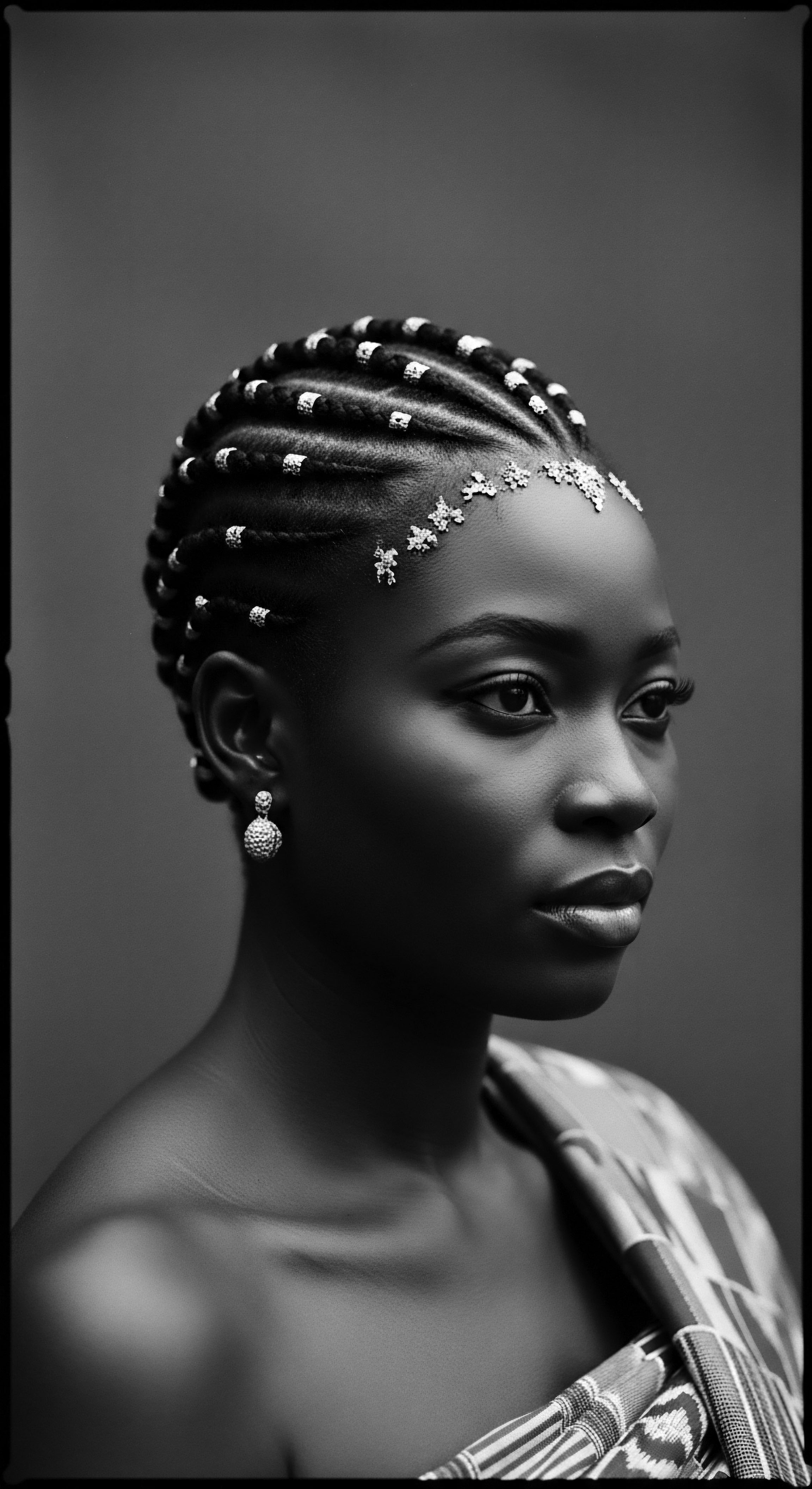
Fundamentals
The spirit of Gourd Hair Care, an ancient and deeply resonant concept, emerges from the very soil of ancestral lands, speaking a language of connection, natural wisdom, and profound respect for textured hair. This concept does not refer to a singular product or a fleeting trend; it represents a holistic approach to hair wellness, drawing its essence from the versatile and symbolic gourd (specifically varieties of the Cucurbitaceae family, such as Lagenaria siceraria, the bottle gourd, and various calabash types). These natural vessels, cultivated for millennia across Africa and subsequently within the global diaspora, offered more than mere utility; they became custodians of ancestral knowledge and extensions of communal well-being. Understanding Gourd Hair Care requires an unhurried contemplation of how these natural forms became intertwined with the very fabric of daily life, particularly within the tender rituals of self-care and communal grooming.
Before the advent of modern containers and manufactured tools, gourds provided humanity with indispensable solutions for storage, transport, and application. They were among the earliest cultivated plants, their sturdy shells, once dried and cured, serving purposes ranging from water bottles and food vessels to musical instruments and ceremonial objects. In the context of hair care, these humble fruits transformed into the earliest, most accessible implements for maintaining and adorning textured strands.
The designation of Gourd Hair Care, therefore, encompasses the practices, philosophies, and material culture surrounding the use of gourds in traditional hair regimens. It is a testament to human ingenuity and the intimate relationship shared with the natural world, particularly within communities that revered hair as a vital aspect of identity, spirituality, and social standing.

The Earth’s Vessels ❉ Elemental Biology of Gourds
Gourds, primarily the bottle gourd (Lagenaria siceraria), represent a remarkable example of nature’s provision. These climbing plants produce fruits with a hard outer shell and varying internal structures, shapes, and sizes. Their cultivation dates back thousands of years, with archaeological evidence suggesting their presence as domesticated plants in Africa as early as 7000–5000 BCE. The biological resilience of these plants allowed them to flourish in diverse climates, providing a consistent, renewable resource for human societies.
Their natural impermeability, once dried, rendered them ideal for holding liquids and semisolids, making them invaluable in daily life. This innate capacity for containment positions gourds as a fundamental element in the historical continuum of hair care, particularly for textured hair that often required rich, emollient preparations for nourishment and styling.
Gourd Hair Care centers on the profound historical and cultural integration of gourds as tools and symbols within ancestral hair practices, especially for textured hair.

Echoes of Utility ❉ Gourds in Daily Life
Across the vast continent of Africa, gourds were not simply agricultural products; they were integral components of domestic existence and ritualistic expression. From the Sahel to the southern regions, these natural forms served myriad functions. In many West African societies, the calabash, derived from the gourd plant, was not simply a vessel; it was an extension of the domestic sphere, intimately linked to personal care. They were used for serving food, carrying water, and storing grains, their shapes often dictating their specific utility.
This pervasive presence in daily tasks meant that gourds were always within reach, ready to be repurposed or designated for specialized functions. Their ubiquity naturally extended their role into the realm of personal grooming, making them readily available implements for hair care rituals performed in homes and communal spaces. The physical characteristics of gourds—their varying sizes, robust shells, and ease of hollowing—made them perfectly suited for evolving into tools of profound significance for hair culture.

First Tendrils of Connection ❉ Hair Care Roots
The earliest forms of hair care for textured hair often involved natural ingredients and simple tools. The intricate coiling patterns of textured hair required specific approaches to cleansing, moisturizing, and styling. These early practices predated manufactured materials, relying instead on what the earth provided. Gourds, in this context, served as critical components in a system of hair care that prioritized natural remedies and community-based practices.
As containers, they held precious oils, herbal infusions, and butters collected from indigenous plants, substances essential for maintaining moisture, promoting growth, and ensuring the vitality of hair. As tools, their smooth surfaces, when cut and shaped, could be used for detangling, smoothing, or even for creating sections in complex braided styles. This foundational role in facilitating the basic needs of hair care firmly places gourds at the very origin of traditional hair practices for those with textured hair, establishing a legacy of symbiotic relationship between humanity, nature, and the hair strands themselves.

Intermediate
Moving beyond the fundamental connection, the intermediate understanding of Gourd Hair Care delves into the deeper implications of gourds as active participants in hair wellness rituals. It explores how these natural forms transitioned from mere utilitarian objects into cherished elements embodying a profound connection to ancestry, community, and the inherent properties of textured hair. The meticulous preparation of gourds for hair-related purposes, the specific ingredients they housed, and the communal activities surrounding their use all contribute to a nuanced understanding of this heritage practice.
Gourd Hair Care, in this context, refers to the systematic and culturally embedded methods by which gourds were consciously selected, prepared, and utilized to enhance, preserve, and spiritually attend to hair, particularly within Black and mixed-race lineages. It speaks to a conscious engagement with plant wisdom, honoring a legacy where every tool held meaning and every ritual fortified identity.

Crafting the Containers ❉ Vessels of Vitality
The transformation of a raw gourd into a functional hair care vessel was an art form, steeped in indigenous knowledge and practical skill. The drying process, for instance, involved careful attention to ensure the shell hardened sufficiently without cracking, preserving its integrity for long-term use. Once dried, gourds could be intricately carved, scraped, or even pyro-engraved, not merely for aesthetic appeal but often with symbolic motifs representing lineage, protection, or fertility.
These decorative elements transformed the utilitarian vessel into a personal artifact, reflecting the individual’s journey and community’s values. As containers, gourds provided a natural, stable environment for storing delicate ingredients.
- Shea Butter (Ori/Karité) ❉ A cornerstone of African hair care, its properties of moisturizing and protecting hair were preserved within gourd vessels, which offered an insulating environment, maintaining its creamy consistency and efficacy.
- Kalahari Melon Seed Oil ❉ Used for nourishing and protecting hair and scalp, its natural integrity was maintained by storage in gourds before modern packaging solutions.
- Herbal Infusions ❉ Various plant extracts, often prepared as washes or rinses, were held in gourds, their natural material thought to maintain the vitality of the botanical concoctions.
- Clays and Powders ❉ Traditional cleansing agents or hair treatments, such as certain mineral clays or powdered herbs, were often kept dry and protected within sealed gourds.
The very act of opening a gourd to retrieve a hair elixir became a sensory experience, connecting the user to generations of ancestral practice. This preservation aspect highlights the gourds’ role in maintaining the potency of natural remedies, a testament to practical scientific understanding inherent in traditional wisdom.

Tools of Timeless Grooming ❉ Shaping and Adorning
Beyond storage, gourds served as direct implements in the grooming process. Their varied shapes allowed for diverse functionalities. Certain elongated or curved gourds, when split and smoothed, could function as rudimentary combs or detangling tools, particularly effective for gently separating tightly coiled strands. The inherent softness of their cured interior, contrasted with the firmness of the exterior, offered a unique tactile experience for the scalp.
For more involved styling, pieces of gourd might be used to section hair, apply thick treatments evenly, or even as molds for specific ancestral hairstyles. The use of these natural tools implies a gentler approach to hair care, prioritizing patient manipulation and respect for the hair’s natural structure. This echoes a fundamental difference from later, harsher tools, underscoring the tender connection traditional communities held with their hair.
The intentional craftsmanship of gourds for hair care reveals a sophisticated understanding of material properties and cultural symbolism.
The presence of gourds in daily hair routines also signals a communal activity. Grooming was often a shared experience, particularly among women, where stories were exchanged, wisdom passed down, and bonds strengthened. The gourd, as a tangible artifact of these moments, became imbued with the collective energy of these intergenerational exchanges.
| Traditional Application (Heritage Context) Storage of unrefined shea butter (ori) to maintain consistency and purity. |
| Modern Parallel/Scientific Link Airtight, amber glass jars for light-sensitive, natural emollients, preserving fatty acid integrity. |
| Traditional Application (Heritage Context) Use of gourd halves as gentle scalp massagers for circulation. |
| Modern Parallel/Scientific Link Scalp massage brushes designed for stimulation and product distribution. |
| Traditional Application (Heritage Context) Gourd sections as detangling aids, minimizing breakage on coiled hair. |
| Modern Parallel/Scientific Link Wide-tooth combs or specialized detangling brushes crafted from natural materials like wood. |
| Traditional Application (Heritage Context) Vessels for communal hair washes and herbal rinses. |
| Modern Parallel/Scientific Link Large bowls or basins for pre-poo treatments and deep conditioning. |
| Traditional Application (Heritage Context) The enduring utility of gourds demonstrates a continuous thread of ingenious adaptation across hair care traditions. |

The Alchemic Chambers ❉ Ingredients and Efficacy
Within the gourd’s protective shell, natural ingredients underwent a kind of alchemy, retaining their vitality and potency. The knowledge of which botanical extracts, oils, or butters to combine for specific hair needs was garnered over centuries of observation and practice. For instance, the use of calabash oil, cold-pressed from the seeds of Lagenaria sphaerica, has been shown to contain a high percentage of essential fatty acids, making it beneficial for nourishing and protecting the scalp and hair. This validates ancient practices that utilized gourd seeds or the fruits themselves for their emollient and fortifying properties.
The efficacy of these traditional remedies was not always understood through modern scientific lenses, yet their consistent application yielded desired results ❉ healthy, vibrant, and resilient textured hair. The gourd, therefore, was not merely a container; it was an integral part of the process, a silent partner in the meticulous art of ancestral hair nourishment, contributing to the overall beneficial outcome.

Academic
The Gourd Hair Care, at an academic stratum, represents an intricate ethnobotanical and socio-cultural construct, articulating the profound interdependencies between human communities, their natural environments, and the meticulous cultivation of identity through hair. This concept extends beyond a mere catalogue of physical tools; it is an analytical framework for comprehending a holistic ancestral system of hair management that positions the gourd, primarily species of Lagenaria, as a central, symbolic, and functional artifact within textured hair heritage. This scholarly delineation of Gourd Hair Care seeks to interpret its multifaceted meaning as a statement of ecological adaptation, a repository of indigenous botanical and dermatological understanding, and a performative medium for cultural continuity. It is an exploration into the nuanced processes through which a readily available natural resource became integrated into the very essence of personhood and communal expression, particularly within African and diasporic contexts where hair has always held immense social, spiritual, and political weight.

Delineating a Heritage Practice ❉ An Ethnobotanical Perspective
From an ethnobotanical viewpoint, Gourd Hair Care signifies a symbiotic relationship between indigenous populations and the botanical world. The extensive domestication of gourds, particularly Lagenaria siceraria, is a testament to their unparalleled utility and adaptability, stretching back to ancient times. This long history of cultivation ensured a reliable supply of versatile receptacles and implements. The practice involved a sophisticated understanding of the gourd’s lifecycle, from planting and harvesting to the curing process that transformed its soft fruit into durable, waterproof containers.
This knowledge, passed through oral traditions and embodied practice, allowed communities to select specific gourd varieties for particular hair care functions, such as those with slender necks for pouring oils or broader, flatter sections for mixing concoctions. This precise selection and preparation illustrate a deeply scientific, albeit empirically derived, knowledge base that underpinned ancestral hair routines. The systematic engagement with gourds highlights not only their physical properties but also their energetic qualities, perceived to harmonize with the human body and spirit.

Psycho-Spiritual Dimensions ❉ Hair as Sacred Conduit
The academic scrutiny of Gourd Hair Care recognizes its significant psycho-spiritual dimensions. For many African and diasporic communities, hair is not merely an aesthetic feature; it is a sacred conduit, a spiritual antenna connecting individuals to their ancestors, their community, and the divine. The scalp, as the highest point of the body, is often considered a gateway for spiritual communication. Practices involving gourds, therefore, transcended physical grooming; they became meditative rituals, fostering a sense of connection and grounding.
A gourd used to collect rainwater for a hair rinse, or one holding an ancestral hair butter, imbued these items with symbolic power. The deliberate act of using a natural vessel, a direct gift from the earth, underscored a philosophy of reciprocity and reverence for life. This aspect is particularly poignant for textured hair, which historically carried both the weight of identity and the burden of colonial erasure, making traditional care rituals a silent act of defiance and affirmation of selfhood. The spiritual component of Gourd Hair Care reinforces the understanding that wellness, for ancestral communities, was an indivisible whole.

The Unseen Economy of Gourds ❉ Sustaining Communities and Knowledge
The widespread application of gourds within hair care also speaks to an unseen economy—a system of sustainable resource management and knowledge transfer that contributed to communal well-being. The cultivation, harvesting, and artisanal preparation of gourds for various uses, including hair care, often involved communal labor and shared expertise. Women, in particular, played a central role in this economy, as custodians of agricultural knowledge, crafting techniques, and traditional hair recipes. This system provided livelihoods, fostered intergenerational learning, and reinforced social cohesion.
The trade and exchange of gourd products, along with the ingredients they contained (such as shea butter, referred to as ‘ori’ in Yoruba, which was also stored in gourds,), further cemented their economic significance. This complex interplay of material culture, social organization, and ecological adaptation defines the comprehensive scope of Gourd Hair Care, illuminating its role as a vital component of historical community resilience and resourcefulness.

A Case Study ❉ Gourds in Dogon Hair and Ritual Practices
To ground this academic interpretation, a specific historical example offers powerful illumination ❉ the pervasive integration of gourds into the daily and ritual life of the Dogon people of Mali . While direct archaeological evidence for gourds as explicit hair combs or brushes is less abundant, their widespread utility in the storage and application of various substances and their symbolic prominence strongly position them within the broader sphere of ancestral hair care. For the Dogon, gourds are more than simple containers; they appear in their rich cosmology, associated with the primordial ark, the theft of seeds, and even held by figures in their masked dances. Anthropological studies confirm the Dogon’s deep connection to the land and their profound integration of natural elements into their daily routines and spiritual beliefs.
Roger Blench’s work on the Ana language of the Dogon group notes the word for gourds (‘kɔdɔ dene’ for small calabashes) and the practice of combing hair (‘se peigner’ for combing). Although not a direct mention of gourd-made combs, the juxtaposition within such linguistic studies highlights the simultaneous existence of gourds and hair grooming in their cultural lexicon. This suggests a subtle, yet pervasive, role of gourds in their overall approach to self-presentation and ritual purity. Gourds are used by the Fulani, who are neighbors to the Dogon, as drinking vessels decorated with designs reflecting their understanding of the universe, and gold and amber hair beads are worn by married Fulani women as a display of wealth, handed down through generations.
This broader context of natural elements, adornment, and intergenerational transfer of wealth suggests an environment where gourds would naturally find their place within personal care. Gourds are also known to have been used as parts of headgear by women in Tourou, a village on the border of Nigeria in Cameroon.
Furthermore, the ceremonial use of gourds among the Dogon, such as those held by dancers in their masks, indicates their symbolic weight beyond mere practical function. A dancer portraying the ‘dyobi,’ or runner, carries a gourd, symbolizing a connection to origins and ancestral journeys. This profound symbolic value suggests that when gourds were employed in hair rituals, they carried an added layer of meaning, elevating the act of grooming into a sacred practice. While perhaps not used to explicitly comb hair, gourds served as essential vessels for the application of medicinal or cosmetic substances on the hair and scalp.
These applications would likely have included traditional oils, herbal washes, or preparations for protective styles, thereby contributing to hair health and appearance. The use of traditional medicinal plants for hair care is also documented in African ethnobotanical studies, with many species identified for general hair care, anti-dandruff, or anti-alopecia treatments. The continuity of such traditional practices underscores the deeply ingrained nature of natural resources in hair health and appearance. The statistic that 81 medicinal plant species from 40 families and 78 genera were identified and documented in an ethnobotanical survey in Ogotun-Ekiti, Nigeria, with leaves being the most used part (57%) and a general reliance on traditional medicine due to its perceived safety and cost-effectiveness, further supports the broad integration of natural elements into wellness, including hair care, and makes the specific use of gourds as containers or tools for these practices highly probable and culturally resonant. This pervasive use of gourds as culturally significant vessels provides a strong argument for their integration into a holistic, ancestral “Gourd Hair Care” system, emphasizing their indirect yet undeniable role in maintaining the health and spiritual integrity of textured hair across generations.

Biological Underpinnings and Indigenous Knowledge ❉ A Convergent View
The academic exploration of Gourd Hair Care bridges traditional wisdom with contemporary scientific understanding. The knowledge embedded within ancestral practices often finds validation in modern biological insights. For instance, the traditional use of gourd juice or extracts for hair benefits, such as preventing graying or hair fall and improving overall hair condition, aligns with modern research into the nutritional content of gourds. Bottle gourd (Lagenaria siceraria) is rich in vitamins, minerals, and dietary fibers, and its seed oil contains essential fatty acids beneficial for hair and scalp nourishment.
The inherent moisturizing and anti-fungal properties found in some gourd species, like ash gourd (Benincasa hispida), demonstrate a scientific basis for their traditional application in treating scalp conditions or dry hair. These examples illustrate a convergence where centuries of experiential knowledge are affirmed by biochemical analysis, lending authority to the intricate systems of care developed by ancestral communities. The resilience and adaptability of textured hair, often subjected to harsh environmental conditions, were supported by these precisely chosen natural remedies and the practical tools—gourds among them—that delivered them. This deeper investigation reveals Gourd Hair Care not as a relic of the past, but as a living testament to profound, enduring wisdom.

Reflection on the Heritage of Gourd Hair Care
Contemplating the Gourd Hair Care concept is an invitation to reconnect with an ancestral rhythm, a slower cadence of being that honored the earth’s bounty and the inherent wisdom passed through generations. It serves as a gentle yet powerful reminder that beauty and wellness traditions are rarely superficial; they frequently carry deep reservoirs of history, ingenuity, and spirit. For textured hair, particularly within Black and mixed-race communities, the narrative of care is profoundly interwoven with resilience and a defiant affirmation of identity.
The gourd, humble in its form, becomes a poignant symbol of this enduring legacy. Its journey from seed to vessel, from utilitarian object to sacred implement, mirrors the journey of textured hair itself – often misunderstood, at times devalued, yet consistently capable of breathtaking beauty and strength when nurtured with understanding and reverence.
This enduring wisdom of Gourd Hair Care offers profound lessons for contemporary hair practices. It nudges us to consider the provenance of our tools, the natural integrity of our ingredients, and the intention behind our rituals. The essence of Gourd Hair Care calls us to remember that true care extends beyond product application; it encompasses a holistic engagement with self and community, an honoring of the heritage etched into every coil and strand.
It is a philosophy that encourages a return to simplicity, an appreciation for what the earth provides, and a celebration of the unique story each head of textured hair tells. The legacy of Gourd Hair Care is a living archive, breathing and expanding with each generation that chooses to understand and incorporate these profound insights into their daily walk, ensuring the soul of a strand remains unbound and vibrant.

References
- Ajetunmobi. “Community Commentary by Ajetunmobi within research project ❉ ‘Rethinking Relationships and Building Trust around African Collections’ 2021. Calabash known as ‘igba’ in Yoruba language undergoes various processes to produce house utensils in traditional Yoruba societies.” Horniman Museum and Gardens.
- Blench, Roger. “Ana, a language of the Dogon group in Northern Mali and its affinities.”
- Iwu, Maurice M. “Handbook of African Medicinal Plants.” CRC Press, 1993.
- Kaplan, Flora S. “The Art of Daily Life in Africa.” African Arts, vol. 30, no. 1, 1997, pp. 30-39.
- Kubde, M. N. A. M. Deore, and V. M. Khobragade. “Lagenaria siceraria (Mol.) Standl. ❉ A Review on its Ethnobotany, Phytochemistry and Pharmacology.” Journal of Pharmacy Research, vol. 3, no. 1, 2010, pp. 119-122.
- McKinley, Catherine E. “The Art of African Hairstyles.” Smithsonian National Museum of African Art, 2014.
- Ntukuyoh, M. E. U. B. A. Ntukuyoh, and A. B. Umoh. “Ethnobotany and Utility Evaluation of Some Species of Cucurbits Among the People of Niger Delta Nigeria.” Journal of Biological and Environmental Sciences, vol. 5, no. 1, 2011, pp. 101-106.
- Oluborode, S. T. et al. “Ethnobotanical study of medicinal plants in Ogotun-Ekiti, Ekiti State, Nigeria.” Smujo, 2023.
- Praan Naturals. “Calabash Oil Nourishes, Protects Hair and Skin.” Cosmetics & Toiletries, 2 July 2020.
- Ranjbar, F. et al. “Cosmetopoeia of African Plants in Hair Treatment and Care ❉ Topical Nutrition and the Antidiabetic Connection?” MDPI, 2021.
- Valentine.gr. “Research/Bottle Gourd. A multi purpose utensil 10.000 old!” Valentine.gr.
